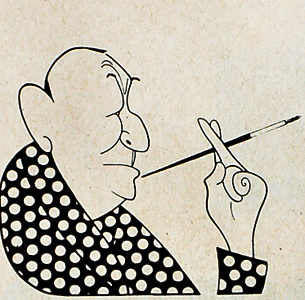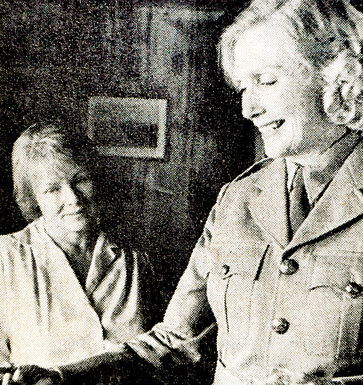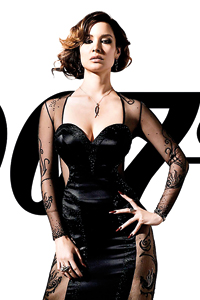Mr. and Mrs. Edgehill: At the edge and end of Empire
On December 15, 1985, in a refreshing change from news items and documentaries on the ethnic crisis in Sri Lanka, viewers of BBC One television in the United Kingdom were treated to a different visual perspective of the country. Ably substituting for a fictitious group of South Pacific islands, Sri Lanka became the location for Mr. and Mrs Edgehill, one of the finest BBC drama productions of the year, starring the acclaimed Judi Dench and Ian Holm.

Multi-faceted talent: Noel Coward
The 90-minute programme was the last of six in a series titled Star Quality based on adaptations of short stories by NoŽl Coward, the others being “Star Quality”, “Mrs Capper’s Birthday”, “What Mad Pursuit”, “Me and the Girls” and “Bon Voyage”. In all, Coward wrote 20 short stories spanning a period of half a century, which are contained in NoŽl Coward: Collected Short Stories (2007). The series showcased Coward’s often forgotten talent for writing bitter-sweet, faintly Maughamesque short stories, on themes very different from those he attempted for stage or screen.
“Mr. and Mrs. Edgehill” is set in the remote British protectorate of the Samolan Islands in the Pacific, just before the Second World War. Eustace Edgehill is a failed entrepreneur whose wife, Dorrie, has supported him with her love, strength and devotion through one doomed enterprise after another. Finally they decide to cut their losses and return to England.
However, one of the remotest islands, Cowrie, looks set to become an important American seaplane station, so the Foreign Office decides to strengthen British claims by appointing a Resident. Edgehill is offered the post and accepts it, much to Dorrie’s remorse. But having decided to return home she then changes her mind and joins her husband on Cowrie, finding to her amazement that he has risen to the challenge.
They are befriended by an English lady and receive a portrait of the king and queen, a symbol of their representation of the British Empire. For the luckless Edgehills, though, things have to go wrong. Relations between them and the Americans working on the island deteriorate and then the Japanese attack Pearl Harbour. Due to the lightning Japanese advance across the Pacific, the Americans decide to evacuate the island and offer to take the Edgehills. Having had no official instructions, however, they decide to await whatever befalls them . . .
Regarding the story, Brad Leithauser comments in a review of The NoŽl Coward Reader (2010) in the New York Times of December 5, 2010: “’Mr. and Mrs. Edgehill’ displays a good deal more writerly patience, a greater willingness to take pains over minutiae of background and motivation, than one might expect from a playwright who once shrewdly remarked of his own fiction: ‘I am inclined to oversimplify my descriptive passages and reduce them to staccato interludes rather than letting them be part of the general structure. This is the natural result of years of dialogue writing.’
“A story like ‘Mr. and Mrs Edgehill’ might serve as a salutary corrective to those who see Coward primarily as a habituť of sharp-tongued drawing rooms. The man had many sides, not all of them prickly. ‘Mr. and Mrs Edgehill’ reminds us of Coward’s highly emotional, if nuanced, patriotism.”
NoŽl Peirce Coward†– he was knighted in 1969 – was truly multi-faceted, achieving success as a playwright with the enduring Private Lives (1930), Hay Fever (1935), and Blithe Spirit (1941). He composed and performed hundreds of songs, the best-known being Mad Dogs and Englishmen (1931); wrote several volumes of poetry; and scripted, directed and acted in the patriotic war film, In Which We Serve (1942), for which he won an Academy Honorary Award in 1943. Significant to this essay is that the film was inspired by the exploits of Captain Lord Louis Mountbatten, who commanded the destroyer HMS Kelly, sunk during the Battle of Crete.
It is somewhat appropriate that Mr. and Mrs Edgehill was made on location in Sri Lanka. In 1943, Coward was performing for the Allied troops in Northern Africa, Palestine and Iraq when he met up with Norman Hackforth, the renowned accompanist and musician. Coward was planning a tour of South Africa at that moment to raise money for war charities and asked Hackforth to accompany him, which he agreed to.
While this tour was taking place, Lord Louis Mountbatten, Supreme Allied Commander South-East Asia Command (SEAC), headquartered at Peradeniya, Kandy, requested Coward and Hackforth to extend their itinerary to entertain the ‘forgotten’ 14th Army in Burma and Assam. Both realised it would be a demanding assignment but also understood they couldn’t refuse.†So Hackforth flew to Cairo to await the journey to India, while Coward sailed from Mombasa on the destroyer HMS Rapid†and used time on the voyage to write “Mr and Mrs Edgehill”.

Star quality: Judi Dench and Rachel Gurney
They met up in Calcutta in early June 1944 and braved the monsoonal conditions to play in Chittagong, the Arakan peninsula, Imphal (the plane preceding theirs was shot down by the Japanese), Assam, back to Calcutta and then on to Bombay, Madras, and finally Colombo and Peradeniya, where they performed for Mountbatten’s staff.
In a letter of thanks to Norman Hackforth (rather than to Coward, as might be expected) dated July 29, 1944, Mountbatten writes: “Although I thanked you and NoŽl publicly at the performance you gave to my Staff, I feel I must also write you a line to reiterate my thanks to you both for undertaking this extremely strenuous tour to the front and for entertaining so many of the Allied Forces in South East Asia.”
Coincidentally, one year after Mr and Mrs Edgehill was shot on location in Sri Lanka, another UK production, Lord Mountbatten: The Last Viceroy, followed. Directed by Tom Clegg, this mini-series (306 minutes) starred Nicol Williamson as Mountbatten, Janet Suzman as Edwina Mountbatten, Sam Dastor as Gandhi and Ian Richardson as Nehru.
I cannot remember how I got involved in Mr and Mrs Edgehill, but I worked on the pre-production assisting with location issues, and hung around during the production waiting for infrequent requests. What I know for sure is my payment and, importantly for the record, the production schedule, for an agreement with the BBC is on file: “we will pay for your freelance services on the basis of $40 per day, on an ad hoc basis, for days worked during the pre-production period, 1 August – 31 August, 1985 and, at the weekly rate of $200 during the filming period, 1 September – 4 October.”
Mr and Mrs Edgehill stars Judi Dench and Ian Holm. By 1984, Dench had established herself as one of the most significant British theatre performers, working for the National Theatre Company and the Royal Shakespeare Company. In television she had appeared in the series A Fine Romance (1981-1984), but her film appearances were infrequent.
By 1984 Ian Holm had built a reputation as an actor for his role as the children’s author JM Barrie in The Lost Boys (1978) – for which he was awarded the Royal Television Society Award for Best Performance, 1979 – the android Ash in the Alien (1979), athletics trainer Sam Mussabini in Chariots of Fire (1981) – for which he was nominated for an Academy Award for Best Supporting Actor – and Napoleon in Time Bandits (1981).
The supporting cast consists of an array of seasoned theatre and television actors – all British apart from Canadian Shane Rimmer, whose face is more familiar than his name, having acted (usually as an American) in Dr Strangelove (1964), Gandhi (1982), Out of Africa (1985), Batman Begins (2005), and in more Bond movies than any other actor. The youngest of the Brits was Amanda Pays, now best-known for her lead role in the remarkable sci-fi TV series Max Headroom (1987-88). The remainder included Raymond Francis, Daphne Goddard, Alan McNaughton, John Harding, Madge Hindle, and Rachel Gurney, who told me she first visited Sri Lanka in the 1950s when she toured the island with an English theatre company.
Mr and Mrs Edgehill is directed by Gavin Millar, whose feature films include Dreamchild (1985) and Complicity (2000), and a host of television films besides Mr and Mrs Edgehill. He is also a respected critic, film writer, and presented Arena, the BBC’s most comprehensive and longest-running arts programme, from 1976 to 1980.
The stoicism of a British couple quietly doing their duty upholding the principle and tradition of British rule in a remote Pacific island location is finely honed in the screen adaptation of “Mr and Mrs Edgehill” by TR (Trevor) Bowen – also an actor – whose script enhanced this beguiling comedy.
Producer Alan Shallcross, whose previous productions included many from the BBC Play of the Month (1975-79), BBC2 Playhouse (1980-83), and more specifically Churchill and the Generals (1979), decided to film Mr and Mrs Edgehill on location in Sri Lanka. It was the first time since Carol Reed’s 1951 Hollywood production Outcast of the Islands that Sri Lanka’s natural beauty doubled for the Pacific.
Filming, as mentioned, took place in September and early October 1985 and despite a week of almost constant rain, the production kept remarkably close to schedule. As Sri Lanka had to represent the Pacific, it was entirely logical that appropriate locations were chosen along the west coast between Colombo and Galle. Here, the palm-fringed bays and limpid lagoons were found by the BBC to be astonishingly like the South Seas, a similarity noted by CG Jung on his visit to Sri Lanka in 1938: “There is already something of the South Seas about it, and a touch of paradise, in which one cannot linger too long”.
The only major set construction was that of the Edgehills’ small bungalow on Cowrie Island, which for script requirements had to be situated just above the high-tide mark. A suitable location was found on the beach at Yakgahagala, and for two months the bay played temporary host to a quaint stone and timber bungalow, complete with cadjan roof.
A suitable Governor’s residence was found in the colonial splendour of Morven, in Queen’s Road, Colombo. Garden scenes at the Governor’s residence were, however, filmed at Brief, near Bentota, the mini-paradise owned by the late Bevis Bawa and frequently used as a film location, including my own film, East of Elephant Rock, nine years earlier.
Perhaps the most picturesque location used was that of the old harbour at Galle. For two days, this sadly neglected but atmospheric spot (prior to Galle’s renaissance in the twenty-first century due to the influx of foreign residents and the advent of the Galle Literary Festival) was briefly returned to its former glory. Swarms of dockworkers loaded and unloaded bundles of cinnamon and other exotic cargoes from waiting boats, while the docks bustled with the activities of bullock-carts, vintage cars and many foreign and local extras.
Other exterior locations included the esplanade at Beruwela and a street in Kalutara, similarly transformed by an imaginative art department into Pacific backdrops. Also used was the water-sports centre at the Bentota Beach Hotel, transformed into an American seaplane station. I was asked to play the part of an American, Geoff Handley, with a couple of lines in which my accent was far from convincing.
A group of Samolan boys were played by Nihal Dayananda, Jayantha Fernando, UDL Gunasinghe, Saman Kannangara and MK Srilal, all residents of the Bentota area. One of the Sinhala film industry’s leading art directors, Dharmasena Hemapala, contributed much to the authenticity and visual appeal of the production. (In 2012 he worked on Deepa Mehta’s adaptation of Midnight’s Children.)
Judi Dench won a British ACE Award (ACE an acronym for “Award for Cable Excellence”, given from 1978 to 1997), for her role in Mr. and Mrs. Edgehill and in her subsequent film career has collected an Academy Award as Best Supporting Actress for her portrayal of Queen Elizabeth I in Shakespeare in Love (1998). She has been nominated for an Academy Award for Mrs Brown (1997), Chocolat (2000), Iris (2001), Mrs Henderson Presents (2005) and Notes on a Scandal (2006). She took over the role of “M”, James Bond’s boss, starting with Golden Eye (1995), and then Die Another Day (2002), Casino Royale (2006), Quantum of Solace (2008) and Skyfall (2012).
In Britain, Dench has developed a reputation as one of the greatest actresses of the post-war period, primarily through her work in theatre, which has been her forte throughout her career. Dench has received many important honours for her work: she was appointed an Officer of the Order of the British Empire in 1970 and promoted to Dame Commander of the order in 1988; hence she is formally referred to as Dame Judith Dench. In addition, she was appointed a Member of the Order of the Companions of Honour in 2005.
Meanwhile Ian Holm has furthered his reputation with his appearances in Dreamchild (1985), Brazil (1985), The Naked Lunch (1991), the lead in King Lear (1998) – he was knighted that year for his services to drama – for which he was nominated for the Primetime Emmy Award for Outstanding Lead Actor, 1999, The Lord of the Rings: The Fellowship of the Rings (2001), The Lord of the Rings: The Return of the King (2003), and The Aviator (2004).
Follow @timesonlinelk
comments powered by Disqus


























